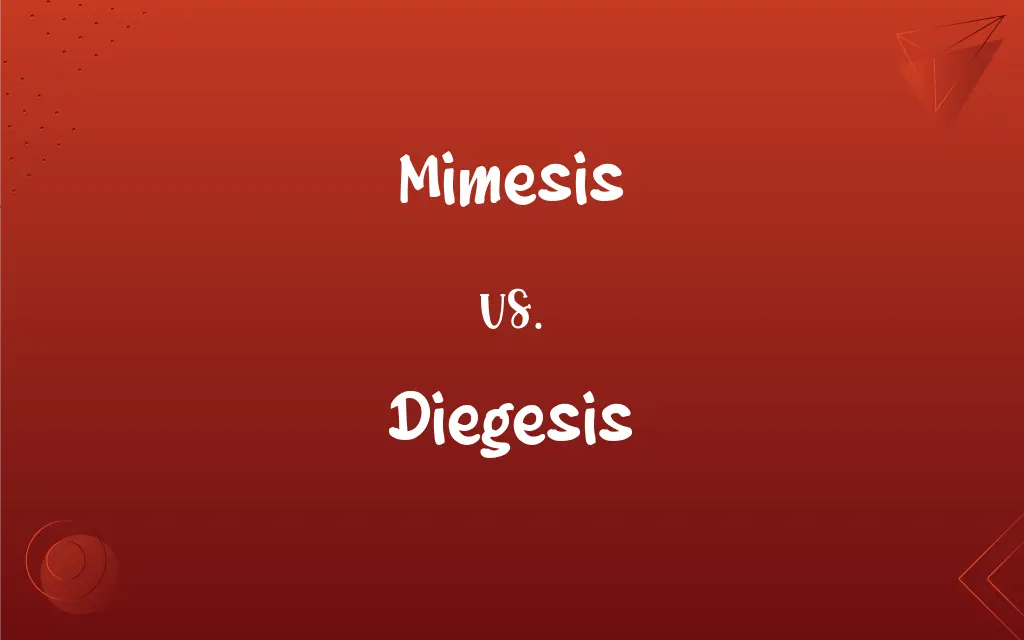Mimesis vs. Diegesis: What's the Difference?
By Janet White & Harlon Moss || Updated on May 23, 2024
"Mimesis" refers to the imitation of reality in art and literature, while "Diegesis" involves the narrative or storytelling aspect, where the events are recounted rather than shown directly.

Key Differences
"Mimesis" is a concept originating from Greek philosophy, particularly discussed by Aristotle, which refers to the direct imitation or representation of reality in art and literature. In mimesis, the audience is shown events as if they are happening in real-time, creating an immersive experience. "Diegesis," on the other hand, is a narrative method where the story is told or recounted by a narrator rather than shown. This term was also derived from Greek philosophy and further elaborated by Plato.
Mimesis focuses on showing, often leading to a more immersive and engaging experience for the audience. For instance, a play that enacts scenes is mimetic. Diegesis emphasizes telling, often resulting in a more reflective and interpretive experience, such as a novel where the narrator describes the scenes.
In visual media, mimesis is akin to scenes and dialogues portrayed directly to the audience, while diegesis involves voiceovers or a character's narration describing the events. Each method offers a different way of engaging with the audience, either by immersing them in the action or by guiding them through the narrative with commentary.
Mimesis creates a sense of immediacy and realism by directly showing actions, whereas diegesis provides depth and context through the narrator's explanations and insights. Both techniques are essential in storytelling, offering unique ways to convey the narrative.
Comparison Chart
Definition
Imitation of reality
Narration or recounting of events
ADVERTISEMENT
Origin
Greek philosophy (Aristotle)
Greek philosophy (Plato)
Method
Showing actions and dialogues
Telling or describing events
Common Usage
Dramatic arts, plays
Novels, literary works
Audience Experience
Immersive and direct
Reflective and interpretive
Example in Media
Scenes enacted in a play
Narrator describing scenes in a novel
ADVERTISEMENT
Mimesis and Diegesis Definitions
Mimesis
Creating a realistic and immersive experience.
The painter’s mimesis captured the essence of the countryside.
Diegesis
Narration or recounting of a story.
The novel’s diegesis provides a detailed background of the protagonist’s life.
Mimesis
Direct imitation of reality in art.
The play uses mimesis to depict historical events on stage.
Diegesis
A storytelling approach that guides the audience through the narrative.
The book’s diegesis helps readers understand the complex plot through detailed descriptions.
Mimesis
Representation of actions and events as if occurring in real-time.
The movie’s mimesis made the battle scenes feel authentic.
Diegesis
Providing context and insight through narrative.
The diegesis in the documentary explains the historical significance of the events.
Mimesis
A method in dramatic arts to show rather than tell.
Shakespeare's plays are rich in mimesis, presenting the story through the characters' actions and dialogues.
Diegesis
The process of telling rather than showing in literature.
The diegesis in the story is handled by an omniscient narrator who describes all events.
Mimesis
A technique to engage the audience by simulating reality.
The virtual reality game uses mimesis to create a lifelike experience for players.
Diegesis
A method where the narrator explains and interprets events.
The film’s diegesis is conveyed through the main character’s voiceover.
Mimesis
The imitation or representation of aspects of the sensible world, especially human actions, in literature and art.
Diegesis
The presentation of a narrative without direct dramatic imitation of the events, scenes, or characters described.
Mimesis
(Biology) Mimicry.
Diegesis
The world that is depicted in a work of narrative art, especially a film.
Mimesis
(Medicine) The appearance, often caused by hysteria, of symptoms of a disease not actually present.
Diegesis
(narratology) A narration or recitation.
Mimesis
The representation of aspects of the real world, especially human actions, in literature and art.
Diegesis
A narrative or history; a recital or relation.
Mimesis
(biology) Mimicry.
Mimesis
(medicine) The appearance of symptoms of a disease not actually present.
Mimesis
(rhetoric) The rhetorical pedagogy of imitation.
Mimesis
(rhetoric) The imitation of another's gestures, pronunciation, or utterance.
Mimesis
Imitation; mimicry.
Mimesis
The imitative representation of nature and human behavior in art and literature
Mimesis
Any disease that shows symptoms characteristic of another disease
Mimesis
The representation of another person's words in a speech
FAQs
Can a narrative use both mimesis and diegesis?
Yes, many narratives combine both methods to enhance storytelling, using mimesis for immersive scenes and diegesis for background information.
How does diegesis differ from mimesis?
Diegesis involves telling the story through a narrator's account, while mimesis involves showing the story through direct representation.
What is an example of diegesis in film?
Diegesis in film can be seen in scenes where a character or an off-screen narrator describes events, providing context and background.
Is diegesis used in first-person narratives?
Yes, diegesis is commonly used in first-person narratives where the story is recounted by a character from their perspective.
Can diegesis create a vivid image in the audience’s mind?
Yes, effective diegesis can create vivid imagery through detailed and descriptive narration.
How did Aristotle and Plato differ in their views on mimesis and diegesis?
Aristotle praised mimesis for its ability to represent reality, while Plato was more critical, viewing it as mere imitation and potentially misleading.
Is mimesis limited to drama and plays?
No, mimesis can be found in various art forms, including visual arts, literature, and films, wherever direct representation of actions is used.
What role does mimesis play in visual arts?
In visual arts, mimesis plays a role in creating realistic depictions of subjects, aiming to represent them as they appear in reality.
What is mimesis in literature?
Mimesis in literature refers to the imitation of real-life events, making the narrative seem realistic and direct.
Which method is more immersive, mimesis or diegesis?
Mimesis is generally more immersive because it shows actions and events directly, making the audience feel part of the scene.
Does mimesis require actors?
In dramatic arts, mimesis typically requires actors to enact the scenes, but in visual arts, it involves realistic depiction without actors.
Do all novels use diegesis?
Most novels use diegesis to some extent, as they rely on narration to convey the story.
Which method is more common in documentaries, mimesis or diegesis?
Diegesis is more common in documentaries, as they often rely on narration to provide information and context.
Can mimesis be found in non-fiction works?
Yes, non-fiction works can use mimesis to recreate events accurately and vividly, making them more engaging.
Does diegesis provide more information than mimesis?
Diegesis can provide more background information and context through narration, whereas mimesis relies on visual and direct representation.
Is diegesis essential for a novel?
Diegesis is often essential for novels as it allows the narrator to guide readers through the story, offering insights and explanations.
Can a single work of art include both mimesis and diegesis?
Yes, a single work can include both methods to balance direct representation and narrative explanation.
What is the primary function of diegesis?
The primary function of diegesis is to narrate and provide a structured account of events, guiding the audience through the story.
Can diegesis include character dialogues?
Yes, diegesis can include dialogues within the narrative, often presented as recounted conversations by the narrator.
How does mimesis enhance a play?
Mimesis enhances a play by making the actions and dialogues seem real and immediate, engaging the audience directly.
About Author
Written by
Janet WhiteJanet White has been an esteemed writer and blogger for Difference Wiki. Holding a Master's degree in Science and Medical Journalism from the prestigious Boston University, she has consistently demonstrated her expertise and passion for her field. When she's not immersed in her work, Janet relishes her time exercising, delving into a good book, and cherishing moments with friends and family.
Co-written by
Harlon MossHarlon is a seasoned quality moderator and accomplished content writer for Difference Wiki. An alumnus of the prestigious University of California, he earned his degree in Computer Science. Leveraging his academic background, Harlon brings a meticulous and informed perspective to his work, ensuring content accuracy and excellence.































































